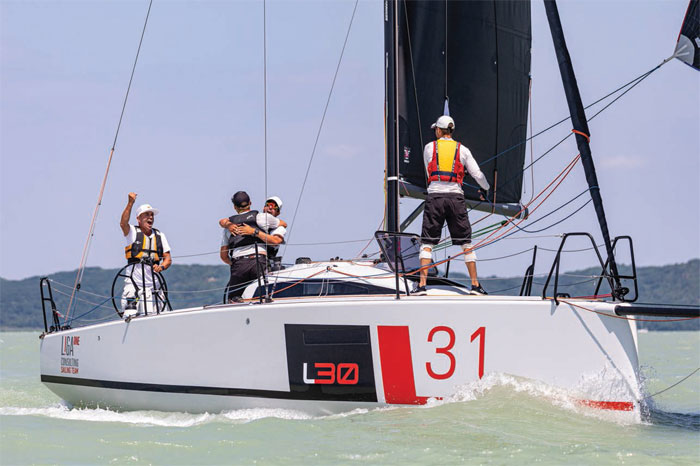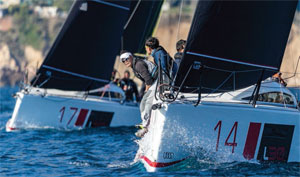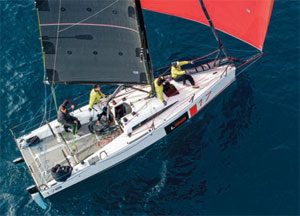

There may not be an offshore medal on the menu at Paris 2024 but one of the favourites to be selected as the platform for the next Olympic Regatta has dusted itself down and is now steaming back into international prominence
How many yachts can you think of that combine 20-knot plus performance and one design racing in decent-sized fleets with Category A offshore certification and weekend accommodation for four people, but can also be trailed behind an average car? And how many of those can be rigged and launched by two people in a couple of hours, without needing a crane? When Rodion Luka went looking for a boat which could do all that, he couldn’t find anything suitable in production. There was a gap in the market, which he decided to fill and thus the L30 was born.
You may have heard about the L30 in 2019, when it was selected by World Sailing for the double-handed mixed offshore world championships and widely assumed to be a shoe-in for the (subsequently abandoned) offshore event at the 2024 Paris Olympics. But there’s a lot more to this nine-metre Swiss Army knife of a boat than that.
Despite being eminently suitable for twohanded racing, the L30 has the size of cockpit you’d expect to find on a 40-footer and for inshore windward-leeward racing it’s ideal for five or even six crew. Despite being built in glassfibre, not carbon fibre, it’s a ton lighter than almost any comparable boat on the market. It’s nimble enough for match racing too, with easily removable stanchions and a full 360° turning circle in just one and a half boat lengths. It’s also forgiving enough, with its runners lashed to the shrouds, to work well as a sailing school boat for novices.
It took three years to design and refine,’ Luka says. ‘Every detail has been very carefully thought out. The idea is not just to race but to sail for pleasure also. It must be easily trailable and it needs to have some accommodation inside because if you build a pure racing boat, no matter how successful it is, in three, five or seven years’ time the class will die anyway.’ Looking to the future, the L30 was developed from the outset with three stages of life in mind. First, as a highperformance one design class offering fleet racing and international competition for teams of amateur sailors. Second, as a teaching platform for sailing schools and also as a club racer on a local level. And then, third, as a lively but easy-to-handle family cruising yacht for private and charter use.
On Russell Coutts’ recommendation Luka commissioned the naval architect Andrej Justin, who designed the RC44, to develop his concept and design the L30. ‘A minivan that must perform like a GT car and fit in a motorbike shed’ is how Justin describes the end result. ‘A project with many contradictory requests ended up with a great sailing boat – a family yacht suitable for one design racing and corporate sailing.’

Practical performance
The L30 is a very different boat to the RC44, of course, but they do have some design features in common and their key parameters are strongly informed by practical considerations. They’re both notably slender with vertical topsides, a flat bottom and a tight turn of the bilge, but while the RC44 is shaped to fit snugly in a 40ft shipping container, the L30’s 2.54m (8ft4in) beam is dictated by European road trailer regulations. They both have a very high ballast ratio – 43.4 for the L30 – rather than relying on form stability, water ballast or crew weight for righting moment, and have a trim tab on the trailing edge of the keel fin to boost upwind performance and give more control when going downwind in heavy weather. ‘As soon as you’re sailing upwind at more than 5kts the trim tab works very well,’ Luka explains. ‘And the L30 goes upwind at 6.8kts, or 7kts on flat water.’ That’s pretty good for a boat with a theoretical hull speed of 7.4kts.
The L30’s narrow beam makes it easily driven upwind in waves and it planes readily downwind, thanks to its flat bottom, at just 8kts of boatspeed and in 12-13kts of breeze. Luka has logged almost 25kts on a reach in rough seas with 33kts of wind; he says 21kts is quite easily achieved by an amateur crew with average skills. Upwind and down, the boat is designed to sail with a heel angle of 18°, which is enough to get some functional benefit from its hard-chined aft quarters. This (along with the sheer size of the gennaker) explains the choice of twin rudders. ‘It’s almost impossible to broach an L30,’ Luka says. ‘You would have to be doing something special.’ The boat also performs well in light airs, with 2.8kts of boatspeed in 1.9kts of wind. The control lines for the lifting keel and trim tab are led up through the keel trunk and aft to the halyard winches on the coachroof. The keel is secured with two pins and one quick-release bolt, and lifted on an 8:1 purchase, reducing the boat’s draught from around 1.9m to less than 60cm. A longer keel fin is available as an optional extra, adding a further 35cm of draught and upping the L30’s RCD rating from Category B to Category A. ‘It’s easy to change keel fins on the trailer, without taking the mast out,’ Luka says. ‘The standard keel is used for one design racing but we have plans for transatlantic fleet racing with the longer keel fin.’ An add-on fairing has also been developed to optimise the keel fin chord for ORC, which favours a lower aspect ratio. The rudders are transom-hung and their blades can be lifted too. On longer races and offshore passages the windward rudder can be raised to reduce drag.
Low cost logistics
One of the most important design criteria was to keep maintenance and logistical costs as low as possible. While the boat and its rig can fit into a shipping container, RC44 style, Luka says that it’s generally cheaper and easier to ship the L30 on its trailer in a Ro-Ro vessel. The carbon mast is deck-stepped to reduce its overhang on a road trailer, and the spreaders are swept back 30° so the boat can be cruised without runners. The headsails are on furlers to minimise the time they spend flogging, giving them a much longer life.

One of the L30’s unusual features is the huge size of its cockpit – ideal for racing with a full crew onboard
Multi-role boat
The man behind the concept, Ukrainian pro racing sailor Rodion Luka, has been an Olympic silver medalist and world champion in the 49er class, a coach on the RC44 circuit and a Volvo Ocean Race helmsman. He came up with the idea for the L30 in 2012 after founding the Kyiv Racing Yacht Club, which runs corporate team-building sailing events, a sailing school and a bareboat charter cruising business as well as a programme of regattas for club members. The versatility required to fulfil all of these different roles with a single type of boat is what lies at the heart of the L30’s DNA.
Many of the components have double or triple uses. For example the padeyes for the jib sheets are used for the mast lifting system, the bowsprit serves as a gin pole when stepping the rig and the bolt eye on top of the lifting keel is designed to take the weight of the boat when launching with a crane. Lines are taken to the aft mooring cleats for stability and it’s ballasted to hang slightly bow down, keeping the mast clear of the crane.
It’s unusual to have twin wheels on a boat like this, but Luka explains that they broaden its appeal. Every year, more than 1,500 people have their first taste of sailing at his Kyiv Racing Yacht Club and he has noticed that when they’ve been on a boat with a wheel, rather than a tiller, they are three times more likely to return for a follow-up session.
L30s are built in Ukraine by Otis Tarda, which won’t be a familiar name to most Seahorse readers but, as a major supplier of composite parts to aero, auto and hi-tech medical clients, plus a wide range of other industries, the quality of its production is assured. However, while the situation with the war in Ukraine remains serious, a second production facility is due to be opened at Oceantec Boatyard in Slovenia, where there is a second set of moulds.
The whole boat is foam-cored vinylester sandwich construction, giving an all-up sailing displacement of just 2,200kg. ‘The total hull weight is 700kg including the deck and everything inside that’s made of GRP,’ Luka says. ‘It’s about one ton lighter than any similar boat on the market and that extra ton equals six tons of CO2, so the L30 is probably the most sustainable 30ft sailing boat in the world.’
The class has been growing steadily, with 34 boats delivered to 13 countries thus far and one design fleets racing in the US, Germany, Hungary and Ukraine. There were 14 teams from eight nations at last year’s Europeans and at least 20 are expected for this year’s event at Sanremo, Italy, 12-16 October. Plans are also afoot for charter fleets in Ukraine, the US and the Middle East.
Click here for more information on L30 Class »
We invite you to read on and find out for yourself why Seahorse is the most highly-rated source in the world for anyone who is serious about their racing.
To read on simply SIGN up NOW
Take advantage of our very best subscription offer or order a single copy of this issue of Seahorse.
Online at:
www.seahorse.co.uk/shop and use the code TECH20
Or for iPad simply download the Seahorse App at the iTunes store


